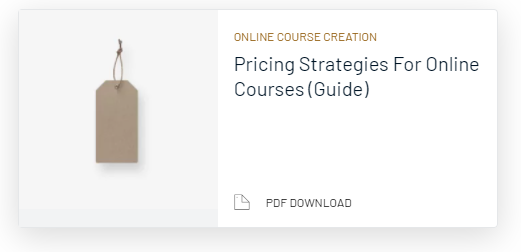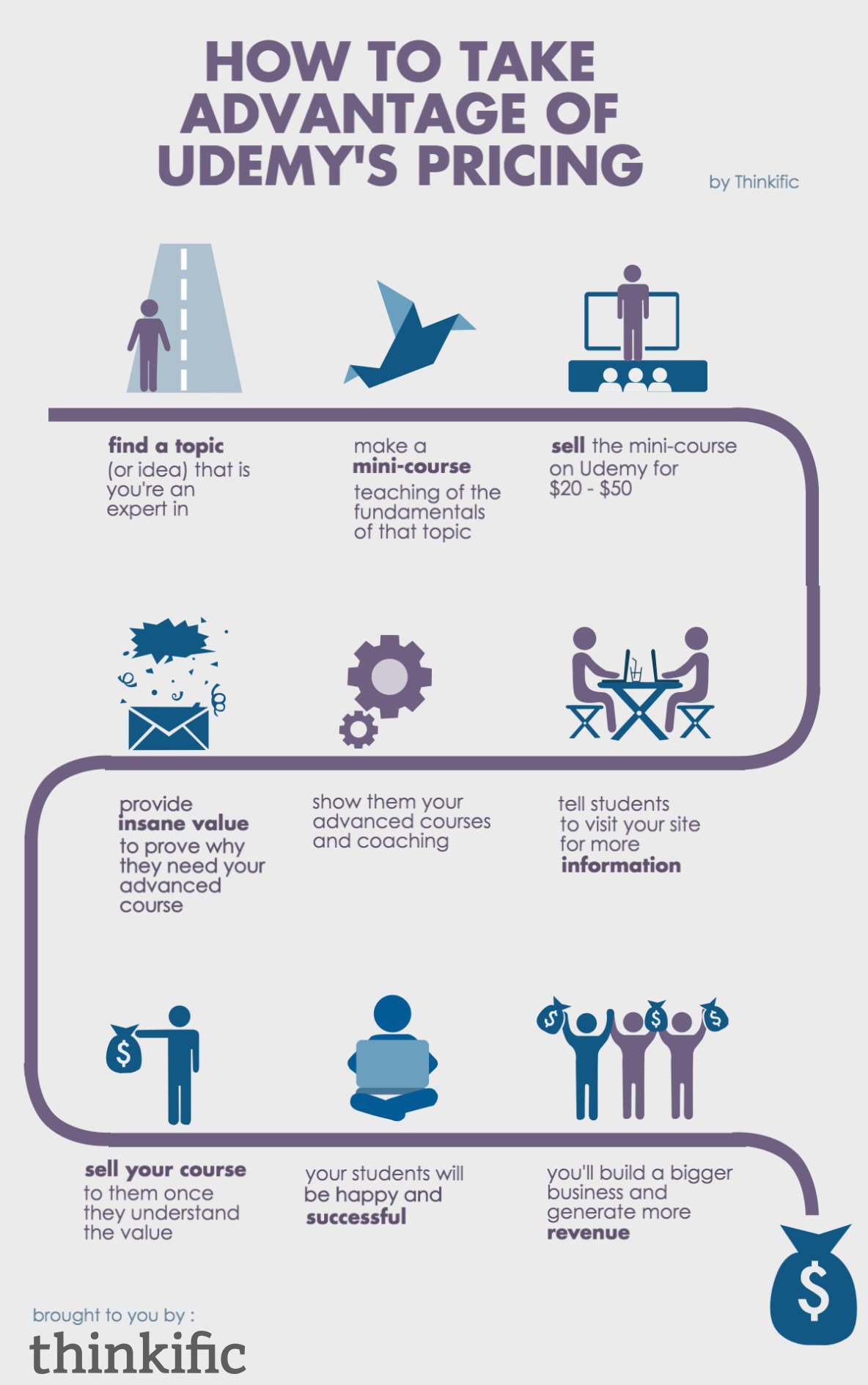This post has been updated to reflect Udemy’s course pricing model in 2020. Enjoy!
Udemy, a popular online course marketplace, has been making a lot of changes to their course pricing model over the years. On April 4th, 2016, for example, they announced that the price of all courses sold on Udemy will be capped at $50 (click here to see their official announcement). This was a big decision for them to make, one that affected thousands of online instructors that are selling online courses on Udemy.
One of the biggest concerns that Udemy instructors had was how this change would affect their online course sales and revenue. Prior to the pricing change, many courses on Udemy were selling their courses for several hundred dollars (up to a maximum of $300). With the new changes, they were forced to reduce their course prices to a maximum of $50 each. Understandably, many Udemy instructors were upset about the pricing restriction, to which Udemy later responded by settling on a maximum price of $199.99 USD for courses sold on their platform (see their current course pricing policy here).
In this post, we’re going to look at the arguments for and against selling online courses on Udemy, and then show you how to use Udemy’s pricing model to your advantage as an online course creator.
Before we dive in, feel free to watch Thinkific’s Co-Founder & CEO Greg Smith’s original response to Udemy’s pricing change back in 2016. Although Udemy has made more changes to their pricing model since then, his suggestions on how to use Udemy’s pricing model to your advantage are still relevant today:
Why Udemy changed its pricing
The short story is that the majority of Udemy students never pay full price for a course. Here’s what Grégory Boutté, the VP of Content at Udemy said about their current pricing model:
“Today, prices are inconsistent and complicated for students. List prices range from $9 to $300, but the reality is that 90% of sales occur with a coupon code, and at a price less than $50.”
Since its inception, Udemy has been notorious for running promotions with large discounts on their courses. In fact, it is not uncommon for them to promote courses at 80% or even 90% off to their database of customers. In doing so, they’ve basically trained their customers to never pay full price for a course. Instead of paying full price, most customers simply wait to receive an email with a promotion before making a purchase.
This data is backed by other top instructors on Udemy, who agree that the massive discounting was a problem. John Colley, who teaches courses on entrepreneurship and business strategy, suspects that the updated pricing policy will help to solve this problem for Udemy instructors.
“I think Udemy is repositioning itself, in the market, to get away from this very heavy discounting strategy. And that is only going to be a positive thing for instructors.”
Scott Duffy, another big proponent of their pricing model, agrees that once the massive discounting culture goes away, instructors will start seeing more impulse purchases at full prices.
“We should start seeing students come to the site and just buying things. Not looking for a coupon, not looking for sales or bookmarking a course, but seeing something they want and buying it instantly. It will take some time for that to develop.”
Phil Ebiner (one of the top instructors on Udemy), who previously priced many of his online courses for $300, said that he rarely gets organic sales at that price. So he decided to test out the new pricing by dropping his courses to $25, and he started seeing more organic sales from them.
“By decreasing the course prices to under $50 and limiting it to just 7 options between $20 and $50, instructors will have a better idea about how much to charge, just based off of the limited options. Students should feel more comfortable to buy courses whenever, and not just during sales. I’m excited about the next price changes and feel like it was the best option for the long run of Udemy’s success (and the success of instructors).”
Why some instructors don’t like the new pricing
Now, it makes sense that reduced course price limit won’t negatively affect course sales for those who never make full-price sales anyway. However, there’s a section of instructors who actually make full price sales of their courses (at $300), and it’s these instructors that weren’t very happy about the changes.
James McAllister is one such instructor. He teaches courses on online business and entrepreneurship, and he consistently makes sales at his price point of $197. When we spoke to him, this is what he said –
“The problem with Udemy’s new pricing approach is that it completely disregards the segment of Udemy’s instructor base that brings their own customers to the platform. Some of us have spent months or even years building credibility with our following and can justify the higher price point – not only because our following has been engaged with us for so long, but because we actually know how to sell the value of our courses.”
Simon Kloot, a professional trader who creates high-quality financial trading and investment courses, says that selling online courses for low prices actually lowers the perceived value of his courses. Many similar courses are worth thousands of dollars and Simon has found success selling his courses at Udemy’s maximum allowed price.
“Selling my course for $50 or less actually cheapens the content and people start to question whether it has any value at all. The thing is, unlike some of the free or extremely cheap financial courses on Udemy, I am not directing traffic to a more expensive course. What you see in my course is the whole package on how to trade from beginning to end. It is why I only ever wrote one course and why I feel it has more value than a whole series of courses that some instructors seem to churn out.”
Simon has a really good point, and we’ve seen how pricing plays a huge role in a buyer’s psychology and perceived value of a course. Higher priced online courses are typically seen to have more value than inexpensive ones. It’s the same psychology that drives people to pay hundreds of dollars for an authentic iPhone versus an inexpensive knock-off.
Higher priced courses have a higher perceived value than cheap ones. #teachonline #onlinecourses Click To TweetAnother major consideration is that online courses are not completely passive. The really good instructors have assignments and quizzes, and are constantly in touch with students, coaching them through the course. As Leilani Joy says, this takes up a lot of time.
“On Udemy, I was offering a 6 week art school training course, that requires me to work directly with students and provide hands-on critiques of assignments. $25 per student ($50 subtract Udemy’s 50% cut) is not even minimum wage for my time.”
This is the reason why millionaire course creators like Marie Forleo and Ramit Sethi don’t use Udemy, and instead, opt for their own branded online course website. They’ve spent years building credibility and thousands of dollars (hundreds of thousands in Ramit’s case) on creating impeccable courses. Plus, the attention they give to each student is worth far more than the $25 they’ll receive from Udemy. It would simply ruin their business.
So what’s the verdict?
Clearly, there are pros and cons to the new pricing model. Some instructors say it will help bring in more organic sales while others correctly point out that it will devalue their advanced courses.
So is Udemy’s course pricing model good or bad for Udemy instructors?
Well, it depends.
If your goal is to generate a significant income by selling courses on Udemy, you’re going to have to sell a lot of courses to make that happen. Udemy (and online course marketplaces in general) are realistically not the best type of platform for building a 6-figure, or even a 7-figure online course business.
But if your goal is exposure, publishing your course on Udemy (or other online course marketplaces) does have some advantages.
If your goal is exposure, there are some benefits to selling your course on #Udemy. #teachonline Click To TweetHow to use Udemy’s course pricing model to your advantage
If you’re a current instructor on Udemy, the changes to their course pricing model aren’t necessarily bad news. Just because you can’t price your courses for more than $199.99 USD each doesn’t mean there is no reason to publish a course on Udemy.
Udemy is a very large platform, with millions of students from around the world. So there is value having a presence there, at least from a personal branding standpoint. Publishing a course on Udemy gives you exposure to hundreds, maybe even thousands of potential students whom you would not have been exposed to otherwise. For that reason, we’re not going to tell you not to publish any courses on Udemy.
How to use the new pricing model at #Udemy to your advantage as an online instructor. #teachonline Click To TweetHere is what we will tell you:
If you’re going to publish your course on Udemy, publish a shorter version of your more advanced and comprehensive course on the same topic. For example, if you have a course that contains over 7 hours of video training (along with mentoring, personal support, access to your private Facebook group, and other things) that you can confidently sell for several hundred dollars, publish a version of that course that does not have the additional mentoring and bonuses and sell it on Udemy at a much lower price.
This way, you get exposure on their platform without giving away all of your valuable knowledge, support, and expertise for an inexpensive price. And you still make a bit of money too. Heck, if all you care about is the exposure, you could even make your Udemy course available for free. If the students who take your mini-course want to take their learning to the next level, invite them to check out the more comprehensive version of your course on a platform that you control (just make sure you do so without violating Udemy’s terms of use).
Publishing a course on Udemy is also a fantastic way to validate the demand for your course topic before you invest a significant amount of time and money creating a more comprehensive version of your course.
Many of the top instructors on Udemy (including Vanessa Van Edwards and Jonathan Levi) follow this strategy. They publish mini-courses on Udemy for the exposure, and then upsell their students a more advanced version of their course, hosted on an online course platform that they can control.
While you can make money by selling your courses on Udemy, that shouldn’t be your primary objective. A better reason to have an online course on a marketplace is for the free exposure to a huge audience and to grow your brand. An online course marketplace is more of a marketing channel for online course creators than anything else.
Once you have that exposure, and you’ve built up a brand, you can bring your audience over to your custom branded site they can buy your higher-priced courses.
The point of #Udemy is to get exposure, not to make money. #teachonline Click To TweetWhat if you want to sell your online course for more than $50?
What do you do if want to charge premium prices for your online courses? What if you want to charge $300? Or $500? Or $1,000 or more? You might already have a premium online course and you don’t want to create another course just for Udemy. Perhaps doing would be inconsistent with your brand or objectives for your business. In that case, the simple answer is: don’t publish a course on Udemy.
You’ve likely spent years acquiring the knowledge and skills that have enabled you to create your course in the first place. If you provide enough value in your course to justify and confidently charge a higher price (a price that customers are willing to pay), then you should most definitely have the freedom to charge whatever you want.
Instead, use a platform like Thinkific, where you have full control over your courses, students, and pricing. No one is going to stop you if you want to charge more for your course. You can create a $2,000 course like Arel Moodie, and sell it with a 6-month payment plan of $375/month.
Related: How to Price Your Online Course (Complete Guide)
The bottom line
At the end of the day, Udemy is a marketplace. As is true of any online course marketplace, they have full control over their policies and restrictions, including the price limits of courses sold on their platform. That’s their business model and they can change it if they feel like it helps their business, their instructors, and their students.
Fortunately, you as an instructor have an option. You don’t have to stay with Udemy if you don’t want to. At the same time, you aren’t in a contract with Udemy, meaning you can sell your courses there as well as on your own site with your own pricing.
Jonathan Levi, one of our most successful customers, for example, published his first online course on Udemy. By leveraging his exposure on their platform, and eventually publishing a premium version of his online course on Thinkific, his online course business grew to over 7-figures in annual revenue. Feel free to read our complete case study on Jonathan here – it’s a pretty inspiring one!
So… should you sell courses on Udemy or from your own platform instead?
Our advice: you don’t have to pick one or the other.
Use Udemy as a marketing channel to drive traffic to your branded site where you can create a profitable and sustainable business that you control. With Thinkific, you can create your branded site in less than an hour!
Download our free Guide to Pricing Online Courses 
What do you think about Udemy’s current course pricing model?
How to use Udemy's course pricing model to your advantage as an online course creator. #teachonline Click To Tweet







